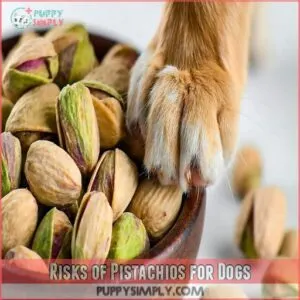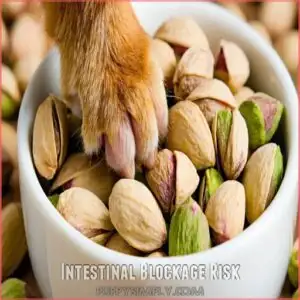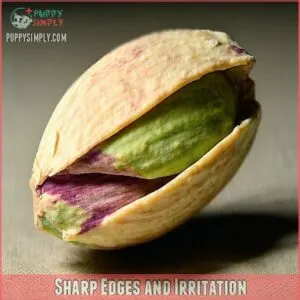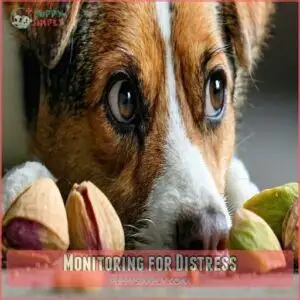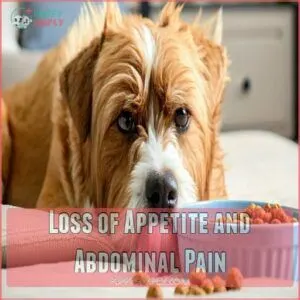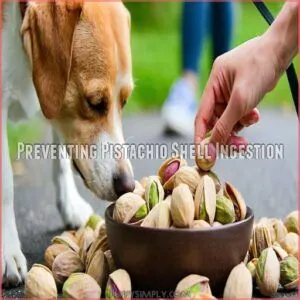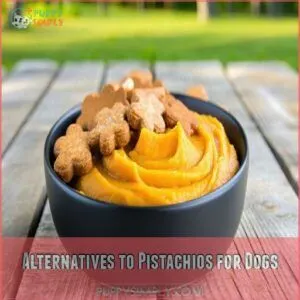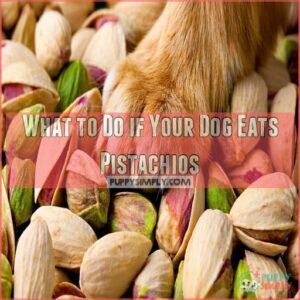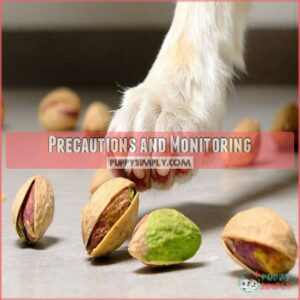This site is supported by our readers. We may earn a commission, at no cost to you, if you purchase through links.
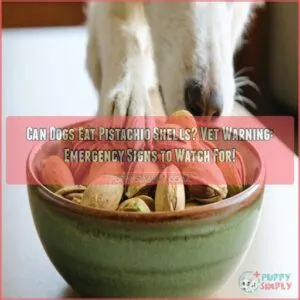
Pistachio shells aren’t toxic, but they can cause a heap of trouble.
They’re tough on a dog’s digestive system and pose a choking hazard.
Imagine swallowing a handful of gravel—ouch!
Dogs can’t digest them, leading to serious issues like intestinal blockages.
Keep an eye out for symptoms like vomiting or stomach pain if your pup sneaks a few.
Always stash these snacks out of paw’s reach.
Curious about safer snack options for your furry friend?
Stay tuned for some tasty treats they’ll love.
Table Of Contents
- Key Takeaways
- Risks of Pistachios for Dogs
- Can Dogs Eat Pistachios Shells Safely
- Dangers of Pistachio Shells to Dogs
- Symptoms of Pistachio Shell Blockage
- Preventing Pistachio Shell Ingestion
- Alternatives to Pistachios for Dogs
- What to Do if Your Dog Eats Pistachios
- Factors Affecting Treatment Options
- Precautions and Monitoring
- Safe Consumption Guidelines
- Frequently Asked Questions (FAQs)
- How many pistachios can a dog eat?
- Which nuts are poisonous to dogs?
- Can dogs eat pistachios?
- What will happen if a dog eats a pistachio shell?
- How many pistachios can a dog eat?
- Can pistachio shell be digested?
- Do animals eat pistachio shells?
- How do pistachios impact a dogs allergies?
- Are roasted pistachios safer for dogs?
- Can puppies eat pistachio shells safely?
- What are signs of pistachio allergies in dogs?
- How to train dogs to avoid pistachios?
- Conclusion
Key Takeaways
- Don’t let your dog eat pistachio shells—they pose serious choking and intestinal blockage risks that can require emergency vet visits.
- Even though pistachio shells aren’t toxic, they’re indigestible and can cause painful digestive issues, including sharp edges irritating the digestive tract.
- Always monitor your dog closely if they ingest any pistachio shell fragments; watch out for symptoms like vomiting, diarrhea, or abdominal pain.
- Keep the shells stored securely out of your dog’s reach, and train them with the "leave it" command to prevent accidental ingestion.
Risks of Pistachios for Dogs
If you’ve caught your dog eyeing your bowl of pistachios, you’ll want to keep those nuts away since they can cause serious health issues like choking, bowel blockages, and even toxic reactions.
Your furry friend’s safety comes first, so it’s important to understand that both pistachio shells and nuts pose multiple risks that could lead to expensive emergency vet visits.
Choking Hazard
Behind closed kitchen doors, your furry friend might snatch up a pistachio shell faster than you can say "drop it!"
These seemingly innocent nuts pose serious choking risks, especially for smaller dogs.
Here’s what makes them dangerous:
- Shell fragments can lodge in your dog’s throat
- Their curved shape makes them hard to swallow properly
- Small breeds are particularly vulnerable due to their narrow airways
Don’t take chances – keep those shells out of reach!
Pancreatitis Risk
Your dog’s love for fatty treats could spell trouble.
The high fat content in pistachios can trigger pancreatitis, a painful inflammation of the pancreas that’ll have your pup feeling miserable, and in fact, nuts like pistachios are bad for dogs.
When you factor in their sodium content, you’re looking at a double whammy for your furry friend’s health.
It’s better to stick with specially formulated dog treats that won’t risk a costly emergency vet visit.
Toxic Components
While pancreatitis is concerning, there’s another hidden danger lurking in pistachios: toxic mold.
These nuts can harbor Aspergillus, producing dangerous Aflatoxin poisoning in your furry friend.
Here’s what makes pistachios potentially toxic for dogs:
- Aspergillus mold thrives in improperly stored nuts
- Salt content exceeds safe levels for canine consumption
- Fat content can trigger severe reactions
- Shell fragments contain harmful compounds
- Mold toxins can cause liver damage
Gastrointestinal Upset
Beyond harmful mold toxins, pistachios can wreak havoc on your dog’s digestive system. Even a few nuts might trigger stomach troubles that’ll have you both racing to the backyard.
| Symptom | Severity | When to Call Vet |
|---|---|---|
| Vomiting | Mild to Severe | Multiple Episodes |
| Diarrhea | Moderate | Lasting 24+ Hours |
| Lethargy | Concerning | Immediate Call |
High-fat dog treats like pistachios can overwhelm your pup’s system, leading to an upset tummy that nobody wants to deal with.
Can Dogs Eat Pistachios Shells Safely
A dog’s curious nature often leads them to investigate tasty-looking pistachio shells, but these seemingly harmless snacks can spell trouble.
The short answer is no – dogs shouldn’t eat pistachio shells under any circumstances.
Even though the shells aren’t technically poisonous, they’re completely indigestible and can cause serious health issues, such as choking hazards, particularly for small dog breeds, as high-fat content risks.
Think of pistachio shells like tiny pieces of wood or plastic – they’ve got no nutritional value and aren’t meant to be eaten.
Instead of risking shell-related complications, stick to dog-safe treats that’ll make your pup just as happy.
If you’re snacking on pistachios, make sure to dispose of shells in a secure trash bin where your four-legged friend can’t reach them.
Remember, prevention is always easier than dealing with an emergency vet visit.
Dangers of Pistachio Shells to Dogs
If you’ve caught your dog munching on pistachio shells, you’ll want to watch them closely since these hard shells can cause serious problems like intestinal blockages and internal injuries.
While one small shell might pass through safely, eating multiple shells puts your dog at risk for emergency surgery, so it’s essential to keep these tempting treats stored safely away from your curious pup.
Intestinal Blockage Risk
Dogs, like curious toddlers, can get into serious trouble when they munch on pistachio shells.
These indigestible snacks can create dangerous intestinal blockages that may require emergency surgery.
If you suspect your dog has ingested pistachio shells, you should check products labeled as pistachio shells dog safe for guidance on how to proceed.
Here are three critical warning signs:
- Frequent vomiting attempts with nothing coming up
- Complete loss of appetite for over 24 hours
- Visible discomfort when touching their belly
Never wait if you spot these symptoms – contact your vet immediately.
Sharp Edges and Irritation
The sharp, jagged edges of pistachio shells can act like tiny knives in your dog’s digestive system.
These fragments aren’t just uncomfortable – they can scratch and irritate the entire digestive tract, from throat to intestines.
Think of it like swallowing broken glass; it’s seriously risky business.
Even a single shell fragment can cause painful cuts and inflammation that might require immediate veterinary attention.
Monitoring for Distress
Watching your furry friend like a hawk after pistachio shell ingestion can mean the difference between peace of mind and an emergency vet visit.
Keep an eye out for unusual behavior changes, labored breathing, or signs of discomfort.
If you notice vomiting, diarrhea, or your pup’s energy levels dropping, don’t wait – contact your vet immediately.
These symptoms could signal a dangerous blockage.
Symptoms of Pistachio Shell Blockage
If your dog has eaten pistachio shells, you’ll need to watch for warning signs of intestinal blockage, including vomiting, diarrhea, and loss of appetite.
You should also check if your dog shows signs of discomfort like whining, restlessness, or a tender belly, as these symptoms can indicate a serious obstruction that needs immediate veterinary care.
Vomiting and Diarrhea
Spotting stomach-upset symptoms like vomiting and diarrhea in your dog can feel like facing a stormy sea.
These digestive issues signal common symptoms of pistachio shell blockage.
If your pup’s spewing more than affection, it might be time for a vet visit.
Keep an eye out for these dog health red flags and always prioritize food safety for your furry friend!
Loss of Appetite and Abdominal Pain
Besides vomiting and diarrhea, loss of appetite is a serious sign.
Your pup might also show abdominal pain, which could be related to a blockage from a pistachio shell, and in severe cases, may require products for dog pistachio shell blockage dog pistachio shell blockage treatment.
Here’s what to watch for:
- He’s refusing his favorite treats.
- His tummy feels hard or bloated.
- He’s whimpering or acting lethargic.
- He’s avoiding belly rubs.
These aren’t good signs; seek vet advice immediately. Don’t delay!
How to Identify Symptoms
Recognizing symptoms of pistachio shell blockage in dogs can be tough.
Keep an eye out for unusual behavior, vomiting frequency, and abdominal pain.
They might seem off, craving comfort.
| Symptom | Frequency | Significance |
|---|---|---|
| Vomiting | Frequent | Digestive distress |
| Abdominal Pain | Persistent | Possible blockage |
| Unusual Bowel Movements | Inconsistent | Gastro issues |
| Reduced Energy Levels | Noticeable | Discomfort or pain |
| Appetite Loss | Significant | Digestive or stress sign |
Preventing Pistachio Shell Ingestion
Keep your furry friend safe by steering clear of pistachio shells. Educate your family about the risks, store nuts out of reach, and train your dog to "leave it.
Educating Family Members
Wondering how to keep your pup safe from pistachio mishaps?
Gather the family for a quick chat about pistachio safety.
Explain the shell dangers—choking hazards and potential intestinal blockages.
Make it relatable by comparing it to swallowing a Lego piece!
Remember, knowledge is power, and with everyone on board, you’re giving your furry friend a safer snack environment.
Safe Storage and Accessibility
Imagine this: a curious pup sniffing out trouble in the kitchen.
Pistachio storage tips are key here. Use dog-proof containers or stash them on a high shelf for safety.
Keeping pistachios out of reach in secure storage areas prevents any kitchen mishaps.
Think defense—a little planning goes a long way in ensuring your furry friend’s safety.
Training Dogs With Leave It Command
Once you’ve kept pistachios out of reach, it’s time to train your dog with the "leave it" command. Here’s how:
- Use treats for motivation
- Practice in quiet places
- Add distractions gradually
- Reward consistently for success
- Incorporate real-life scenarios
Consistent practice and real-world scenarios will help your pup learn when to back off those tasty dangers.
Alternatives to Pistachios for Dogs
When you’re thinking about giving your furry friend a treat, consider safer options than pistachios.
Nutritious dog treats, plain pumpkin, or a few carrot slices are great choices that your dog will love and are better for their health.
Nutritious Dog Treats
Switching from pistachios? Smart move!
Many commercial brands offer healthy dog snacks designed to your pup’s dietary needs.
Check labels for ingredient analysis – you want simple, wholesome stuff.
Homemade dog treats are a fun option, too.
Just remember, moderation’s key!
A balanced diet is your dog’s best friend.
Safe Human Foods Like Pumpkin and Carrots
When you’re looking for dog-friendly snacks, pumpkin and carrots are real winners.
Pumpkin benefits your pup with fiber and nutrients, making it great for digestion.
Carrot benefits include vitamins and a satisfying crunch that even picky eaters enjoy.
These healthy alternatives are safe human foods, adding variety to your dog’s diet without the risks of pistachios.
Lean Protein Sources for Dogs
Consider chicken breast, turkey thighs, and salmon fillets as protein-packed options.
They’re like gourmet treats for your pup without the pistachio risks.
Beef scraps and lamb chops in moderation are also a hit, offering a savory twist to their diet.
These alternatives help your dog enjoy tasty meals while staying healthy, skipping pistachios altogether.
Practical and safe!
What to Do if Your Dog Eats Pistachios
If your dog munches on pistachios, it’s important to quickly assess their condition and determine if any immediate action is necessary.
Whether you’re taking a wait-and-see approach or opting for a more immediate veterinary intervention, being prepared can prevent potential health issues.
Wait and See Approach
If your dog manages to munch on a few pistachio shells, don’t panic just yet.
It mightn’t be snack time gone wrong!
Check the dog’s size and shell quantity eaten, and watch for symptoms.
If your dog seems fine, a wait-and-see approach can work.
Keep an eye on them, and consult your vet if anything seems off.
Aggressive Veterinary Approach
Spotting signs of pistachio shell trouble? It’s time for the aggressive approach. Head straight to the vet for:
- Emergency surgery: To nip a blockage in the bud.
- Vet visit urgency: Every minute counts.
- Immediate treatment: It helps dodge bigger issues.
- Critical intervention: Keeps your furry friend safe.
Don’t wait around; act fast for your pup’s sake!
Administering Tagamet (Cimetidine)
Cimetidine, known as Tagamet, might help if your dog accidentally munches on pistachios.
However, it’s important to know the risks of pistachio consumption, including the high fat content that can lead to pancreatitis and weight gain, as discussed in the dangers of pistachio ice cream for dogs.
This medication eases stomach discomfort by reducing acid production.
But remember, it’s not a cure-all. Cimetidine dosage should always be veterinary-approved to avoid unpredictable Cimetidine side effects, like digestive upset.
For safer snacking, consider alternatives like pumpkin or carrots, seamlessly swapping pistachios for a happy, healthy pup.
Factors Affecting Treatment Options
Your dog’s size and how many shells they ate are key factors in deciding on the best treatment.
Your vet will also consider your dog’s symptoms and overall health when recommending a course of action.
Dog’s Weight and Ingested Amount
Regarding your dog’s weight and the amount of pistachio shells they’ve ingested, size really matters.
A small pup gobbling more shells faces higher risks than a larger dog.
You can use a dog weight chart to get a better idea of your dog’s weight range and how that might affect the severity of the situation.
Think of it as comparing a ping-pong ball to a basketball—more room, less danger.
Always weigh your dog’s size with the shells ingested to gauge ingestion risk effectively.
Abdominal Sensitivity and Distention
Your dog’s tummy woes might stem from abdominal sensitivity and distention. Imagine their belly feeling like a pressure cooker of trouble. Here’s what to look for:
- Causes: Pistachio shell ingestion
- Symptoms: Bloating or tenderness
- Treatment: Monitor closely
- Prevention: Keep pistachios out of reach
If you notice changes in your dog’s poop schedule or signs of dehydration, it may be a sign of constipation, which can be as serious as intestinal obstruction risks. Quick attention can ease discomfort and prevent complications.
Veterinary Advice and Guidance
Feeling your dog’s abdomen can be like checking for potholes—unexpected bumps might signal trouble.
If pistachios are involved, it’s time to chat with your vet.
They’ll guide you on whether a cautious approach is enough or if it’s time for X-rays.
Safeguarding your pup’s health with expert advice makes sure they enjoy safe snacks and tasty treat alternatives.
Precautions and Monitoring
When your dog eats pistachio shells, similar to the dangers of crab shell ingestion risks, it’s essential to be aware of the potential for gastrointestinal complications. When your dog eats pistachio shells, it’s important to monitor them closely, as the risk of obstruction is uncertain.
If they show symptoms like vomiting or pain, your vet might recommend X-rays and IV fluids for further evaluation.
Uncertainty of Obstruction Risk
Obstruction risk factors can leave any dog owner uneasy.
Shell size and a dog’s breed impact how risky pistachio shells actually are.
Some dogs might handle small shell pieces, while others could face trouble. It’s much like humans and spicy food—tolerance varies.
Always watch for telltale signs and remember, shell digestion is unpredictable.
Keep those curious snouts safe!
Recommended X-rays and IV Fluids
Spotting a blockage risk isn’t always straightforward.
If your vet suggests X-rays, don’t hesitate—it’s a roadmap for pinpointing issues you can’t see.
Sometimes, adding IV fluids benefits in easing any blockages.
Their role in emergency care and diagnosis is critical, flowing through your dog’s system like a river, and potentially flushing out what’s causing the blockage.
Vigilant Monitoring and Potential Symptoms
Your dog’s eaten pistachio shells? Don’t panic, but stay vigilant!
Watch for changes in your dog’s behavior; are they less playful?
Note any signs of pain, appetite changes, or vomiting frequency.
Check their stool consistency.
Even subtle changes warrant a call to your vet.
Early detection is key!
Safe Consumption Guidelines
When you’re treating your dog to pistachios, stick to just one or two unshelled, unsalted nuts, and make it an occasional indulgence.
Always consider your dog’s size and health conditions, and consult your vet for personalized advice.
Limiting Unshelled and Unsalted Pistachios
Even with all precautions, you’ll want to limit those pistachios.
Stick to unshelled and unsalted versions, and only offer them as an occasional treat.
Remember, your dog’s diet should mainly focus on meeting their nutritional needs with safe treats and healthier pistachio alternatives.
A few here and there are fine, but treat frequency should be low.
Considering Dog’s Size and Health Conditions
Size does matter in terms of giving pistachios to your dog, as small breeds are more susceptible to pancreatitis and other health concerns, similar to the risks associated with almonds and pancreatitis.
Small breed risks are higher due to their size, making them more prone to health concerns.
Keep an eye on pre-existing conditions like pancreatitis or obesity.
Consider their dietary needs carefully; what’s okay for a big dog mightn’t suit a tiny pooch at all.
Consulting a Veterinarian for Nutrition Advice
Got a pup with special dietary restrictions or curious about the best treats for dogs?
Consulting your vet is like having a GPS for dog nutrition.
They’ll guide you through dog food brands, nutritional supplements, and any allergies or sensitivities to watch for.
It’s not just about pistachios; understanding your dog’s unique needs keeps their tail wagging!
Frequently Asked Questions (FAQs)
How many pistachios can a dog eat?
One or two unshelled, unsalted pistachios are okay as an occasional treat. Don’t make them a daily snack! Too many can upset their tummy. Always check with your vet first.
Which nuts are poisonous to dogs?
Macadamia nuts are toxic to dogs, causing weakness, vomiting, and tremors.
Black walnuts and pecans can also be harmful due to mold toxins.
Always keep these nuts out of your dog’s reach to protect their safety.
Can dogs eat pistachios?
Dogs shouldn’t munch on pistachios regularly.
These nuts can be a choking hazard, especially in small breeds, and large amounts may upset their stomachs.
Only offer one or two unshelled, unsalted pistachios occasionally, if at all.
What will happen if a dog eats a pistachio shell?
If your dog munches on a pistachio shell, it might face choking or an upset stomach.
Ingested shells can also cause blockages.
Keep an eye out for vomiting or discomfort, and contact your vet if needed.
How many pistachios can a dog eat?
Feeding pistachios is like walking a tightrope; it’s best to give one or two unsalted, unshelled pistachios occasionally.
Always consider your dog’s size and health first, and consult a vet for personalized advice.
Can pistachio shell be digested?
Pistachio shells can’t be digested by your dog and might cause blockages.
While a small piece often passes without issues, consuming many can create serious problems.
Keep an eye out for any signs of distress or discomfort.
Do animals eat pistachio shells?
It might seem cute, but animals eating pistachio shells isn’t natural and could be risky.
Those sharp shells aren’t digestible and can cause blockages or irritate an animal’s internal system.
Keep them out of your pet’s reach.
How do pistachios impact a dogs allergies?
They don’t typically trigger allergies, but a pistachio’s high fat content might upset your dog’s stomach. Watch for vomiting or diarrhea; if it happens, cut out the nuts.
Are roasted pistachios safer for dogs?
Roasted pistachios aren’t necessarily safer for dogs.
While they might have less mold than raw ones, the high fat and sodium still risk causing gastrointestinal issues or pancreatitis.
Keep your furry friend away from these tempting treats.
Can puppies eat pistachio shells safely?
Puppies shouldn’t munch on pistachio shells—think of them as tiny landmines.
They pose a choking hazard and risk intestinal blockages.
Instead, stick to puppy-safe treats and keep pistachios well out of paw’s reach.
What are signs of pistachio allergies in dogs?
Signs of pistachio allergies in dogs can be sneaky.
Look for itchiness, paw licking, skin redness, or even vomiting.
Your pup might develop swollen eyes or ears.
If you spot these symptoms, it’s vet time!
How to train dogs to avoid pistachios?
Train your dog to avoid pistachios by teaching the "leave it" command.
Reward them with treats and praise when they obey.
Store pistachios out of reach, and educate family members about the potential dangers.
Conclusion
Imagine this: your dog’s health hanging in the balance over a few pistachio shells.
While pistachios’ green gems seem tempting, their shells spell trouble for our furry ones.
From choking hazards to intestinal blockages, the risks aren’t worth the crunch.
Always prioritize safety by offering dog-friendly snacks and keeping pistachio shells out of reach.
When in doubt, a quick vet chat can save your dog from danger and keep tails wagging happily.
Stay pawsitive by making safer choices!

